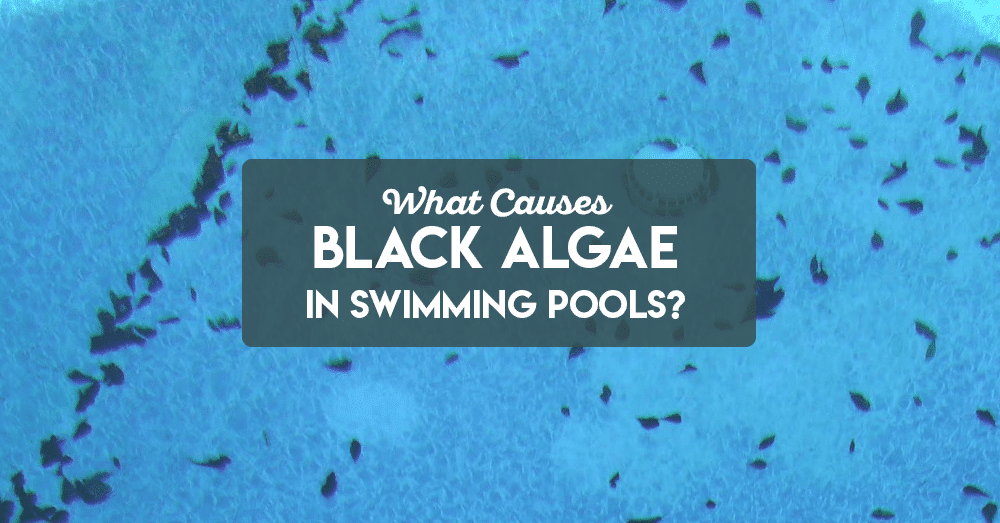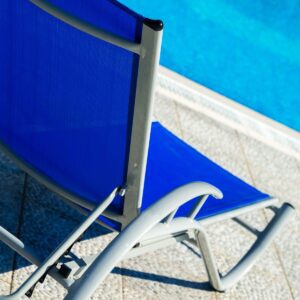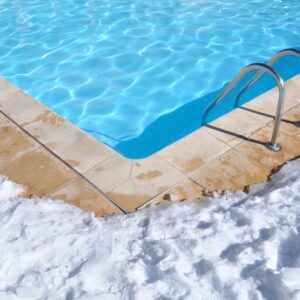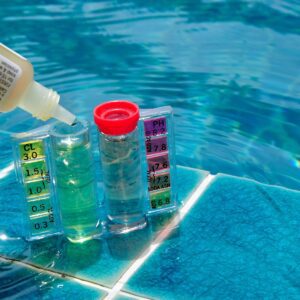Swimming pools are all fun and games until harmful organisms infest your pool. Black algae are one of the worst organisms to infiltrate your pool. Not only do they create a dirty, disgusting look to your pool, but accidentally ingesting pool water with black algae can lead to major health problems.

Read Next
The good news is, you are almost entirely in control of black algae entering your swimming pool. Black algae won’t just magically appear in your pool and start growing overnight.
Learn what causes black algae in swimming pools so you can keep your friends and family safe all summer long while enjoying your pool.
What Is Black Algae
Black algae (also known as blue-green algae or cyanobacteria) is a type of aquatic organism that thrives in water.
Black algae get its color from chlorophyll which provides a green hue and water-soluble pigments which cover the green coloration to create more of a blue-green or black color. This type of bacteria closely resembles the look of dark mold.
Unfortunately, black algae can be tough to get rid of once it's been brought into your pool.
Signs You Have Black Algae In Your Pool
If you’re worried you might have black algae in your swimming pool, here are some tell-tale signs of black algae to keep on your radar.
- Dark clumps are attached along your pool’s surface.
- You have difficulty removing dark spots found on your swimming pool’s walls no matter how hard your scrub or scrap.
- The blue-green or black spots don’t float and have mold-like raised heads.
- The dark spots appear on rough, textured, porous materials on your pool.
Knowing what black algae look like can help you act quickly to fix the problem at the first signs of this troublesome bacteria.
What Causes Black Algae In Pools
The primary way black algae can enter your swimming pool is by an external source, such as an unwashed swimsuit with the bacteria attached, entering the pool.
Black algae don’t naturally take form in your pool overnight out of nowhere. Whether it be an unwashed swimsuit, toy, or another external source that had not been properly washed.
Whatever the case, any outside item that got black algae attached to it from previously being in a lake, river, or other area exposed to the troublesome bacteria, if not washed, can be the cause for all your black algae pool woes.
Once black algae have entered your swimming pool, it’s extremely difficult to get rid of. Therefore, to prevent this situation, always remember to thoroughly wash all items (swimsuits, swimming gear, toys, etc.) whenever you visit a lake or river.
Black Algae Can Easily Grow In Your Pool
After your swimming pool has been infested with black algae, it can easily multiply and grow throughout your pool. That’s why it’s essential you take effective, timely action to reduce the spread of black algae in your pool.
Black algae growing in your swimming pool is a frightening sight for any pool owner. Find out steps you can take to get rid of this bacteria in your pool.
How To Get Rid Of Black Algae In Your Pool
Just because black algae is a nightmare to get rid of doesn’t mean you can’t fix your black algae problem.
Arguably the best line of defense to efficiently get rid of black algae in your pool is hiring pool professionals. However, there are steps you can take to fix your black algae problem yourself.
Hire A Professional To Remove The Black Algae In Your Pool
Removing black algae in your swim pooling is challenging. That’s why, it’s recommended you hire pool professionals who already have the proper tools, products, and experience necessary to effectively remove your black algae.
Steps To Remove The Black Algae Yourself
If you decide you don’t want to hire a pro, and want to try removing the black algae yourself, follow these 6 steps to effectively remove black algae from your swimming pool.
Step 1: Obtain Proper Tools For Black Algae Removal
Before diving into removing the black algae from your pool, it’s essential you gather all the necessary tools and products to get the job done right.
Tools and products you’ll need to help with your black algae removal include:
- Goggles
- Gloves
- Water Testing Kit
- Filter Cleaner
- Replacement Filter (if necessary)
- Chlorine Tablets
- Pool Algae Brush
- Hose
- Calcium Hypochlorite Shock
Step 2: Clean Your Pool Filter
Once you’ve obtained the above tools, start by cleaning your current pool filter. Remove all black algae from your filter. This will lower the risk of black algae reinfesting your pool upon going through this entire removal process.
To clean your current filter, use a filter clean solution and thoroughly wash off the algae.
If you find there’s an abundance of black algae on your original pool filter, change out the filter entirely with a new replacement filter.
Step 3: Test Your Pool’s Water Levels
Use your water testing kit to check the pH, alkalinity, and chlorine levels of the water in your swimming pool. Assess each level, ensuring each test comes back in range. If a level comes back out of range, correct the issue accordingly before continuing to the next step.
To Correct Abnormal pH Levels: A normal pH for pool water is between 7.4 and 7.6. Add pool pH reducer or pH increaser according to your pool water’s level.
To Correct Abnormal Alkalinity Levels: Normal alkalinity levels range from 100 ppm to 150 ppm. Add an alkaline increaser or alkaline reducer to your pool according to your pool water’s measured alkalinity level.
To Correct Abnormal Chlorine Levels: Chlorine levels should be anywhere from 1ppm to 5 ppm in your pool water. Add more chlorine to your pool to raise your chlorine level if necessary.
Step 4: Scrub Your Pool (Hard)
Use your pool algae brush (such as a steel-bristle brush or a tough bristle brush) to scrub thoroughly against your pool’s surface.
Step 5: Shock Your Pool
After you’ve given your pool a nice hard scrub, the black algae will be floating in your water. Therefore, you must shock the pool water and all the tools you used to scrub the pool.
Carefully add your pool shock product, following the provided instructions on the product. Add 4 times the suggested amount to shock your pool and turn on your pool pump over the next day.
Step 6: Clean Your Filter A Second Time
After the day has passed, and you’ve consistently scrubbed off any black algae during this time that’s attached itself to your pool’s surface, clean your pool filter again with a filter cleaner.
If you still see black algae in your pool, consider repeating the process again or hiring a professional to remove the black algae from your pool.





Bob says
Thank you for a very informative article. I do have one question.
Since black algae needs to have its protective coating brushed off in order for chemicals to get to it to kill it, when cleaning filter cartridges, can you recommend a filter cleaner that can remove black algae from the cartridges without the coating being removed?
Rex says
To remove black algae from pool filter cartridges without having to scrub off the protective coating first, I recommend using a two-step chemical treatment. Start by adjusting your pool water to the correct pH and alkalinity levels. Then, apply Suncoast Metal Control to the water, which helps soften the tough outer shell of the black algae, making it more susceptible to treatment. After this, add Suncoast Super Black Algaecide according to the package directions, which is specifically designed to target and kill black algae.
It's important to brush the filter cartridges daily during this treatment to aid in the algae removal process. If the infestation is severe, you may need to repeat this treatment or consult with a pool care professional for further assistance. This method should allow the chemicals to effectively reach and destroy the black algae without the need for physical removal of the coating.